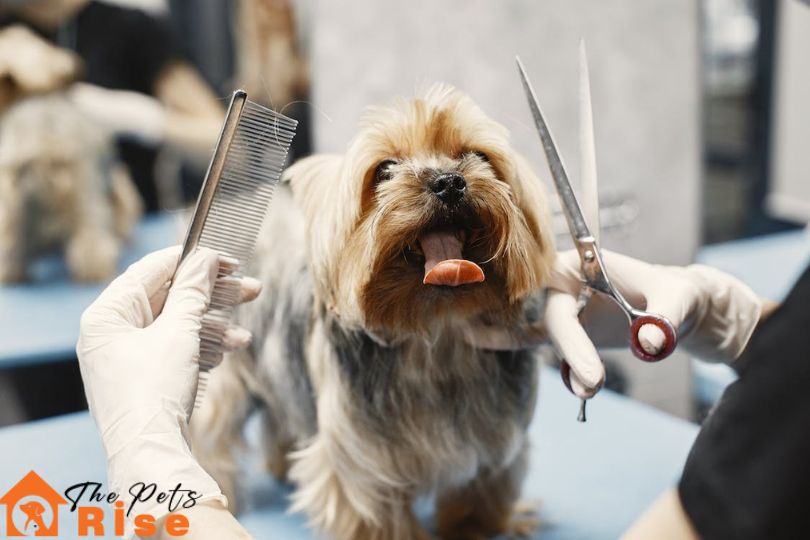Sarah thought it would be easy to groom her Rottweiler, Brutus. After all, he was loyal and kind to her and was a good guard dog. However, she was alarmed when Brutus showed his teeth. She later found out that she had cut the nails down to the quick – too far down for comfort. That’s because the quick represents the part of the cuticle that holds nerves and blood vessels. It is usually found at the curve of the nail, so you don’t want to pass this point whenever you trim your dog’s nails.
After all, the idea of grooming your dog yourself is to strengthen your bond. So, you want to make sure you know what you’re doing when you take on grooming as a do-it-yourselfer.
10 Best Practices to Follow for Grooming Your Dog at Home
Follow the steps below so you can make dog grooming at home both pleasant and enjoyable.
1. Assemble the equipment.
Before getting started it’s important to gather all the tools. Some basic grooming supplies include the following:
- A dog-friendly brush. If your dog has a smooth and short coat, you’ll need to use a soft bristle brush, a grooming glove, and/or a rubber-made curry brush. For a dog with a medium or long coat, use a pin brush or slicker brush as their primary brush.
- Grooming scissor
- A nail clipper or grinder
- Comb
- Adjustable grooming table
- A shampoo and conditioner designed for canines (don’t use human shampoos or conditioners)
- Towels
- Hair dryer
It’s best to invest in high-quality tools that are specific to your dog’s needs. It’s worth the investment, especially if you’ve committed yourself to the activity.
2. Set up the environment.
Acquaint your pet by allowing them to sniff the equipment you plan to use. Try out each grooming aid on your dog first so it doesn’t come as an unwelcome surprise. Use some patience, as some pets are more nervous than others. Therefore, focus on calming and reassuring your dog. When switching on electric equipment, like a nail clipper or grinder, allow your pet to get used to the sound. As you brush your dog, run the bristles over your pet’s back gently but don’t penetrate the fur until they’re ready.
3. Use treats
For a pet that is squeamish, reward them with treats. When they sit still or stand, as you instruct, give them a reward – a treat and verbal praise. Pat them softly on the back. They will start to connect and become more relaxed. Remember, only give your dog a treat when it obeys and is calm. Extend the time between giving treats as the dog progresses.
4. Take a break, if needed
If the grooming process becomes too much, take a break. To gain your pet’s trust, it’s important to stop grooming when they start to feel uncomfortable. By introducing breaks, they’ll become less stressed over time. The key is to groom little but frequently to build trust. Only increase the grooming time when the dog is entirely relaxed.
5. Begin with brushing sessions
Brushing removes loose hair, dirt, and dander from your dog’s coat and ensures the distribution of natural oils. This will give your dog’s coat a healthy sheen. For example, if your dog has a medium or long coat, you might start with a slicker brush to untangle and get rid of mats. Follow with a bristle brush or comb as a finishing touch.
6. Keep your pet’s nails properly trimmed.
Allowing your dog’s nails to become too long can lead to discomfort or even injuries. Regular dog nail trims are therefore important for their well-being. If you’re new to nail trimming, you might consider using a nail grinder as it provides more control and reduces the risk of cutting quickly.
If you use nail clippers, only cut small amounts of the nail at one time. You can see the quick easily if your dog’s nails are light-colored – not so easily if they are dark. Cut the nail from top to bottom instead of side to side. Doing so will help you maintain the nail’s natural curve.
After each cut, check for the quick. This means looking at the underside of the nail. In the cut portion, the bottom is light and the top is dark. The quick will resemble a pink or small gray oval inside the nail.
7. Give your dog a bath
Choose a shampoo specifically designed for dogs and carefully follow the instructions provided. Rinse with lukewarm water. If necessary, apply conditioner. Then gently towel dry the dog’s fur. Finish off by using a hairdryer on low heat. Move the dryer around to prevent problems with overheating.
8. Trim the hair when needed
Use grooming scissors to trim any unruly hair. Use extreme care on sensitive areas like ears, paws, and around the eyes. Remember to point the scissors away from your pet’s skin to prevent an accidental injury.
9. Take care of your pet’s ears
Regularly cleaning your dog’s ears can help prevent infections. Ask your veterinarian about what to use for an ear cleaner. Some cleaners, which contain hydrogen peroxide or alcohol, can irritate the canal, especially if it’s ulcerated or inflamed.
You’ll need a cotton ball and a quality cleaning solution. Never use a Q-tip, as it can perforate the eardrum or traumatize the ear canal. It may also push any debris further inside the ear. All dogs do not need to have their ears cleaned. However, you should clean your dog’s ears if you notice any odor or discharge. Always consult with your vet first. The ear could be infected or your pet may have ruptured their eardrum.
Ear cleaning tips
- When cleaning the ear, grasp the pinna (ear flap) to expose the canal. Fill the canal with solution. (Note: Don’t place the tip of the bottle into the ear, as it can spread bacteria. Clean the tip with alcohol if it happens.)
- Hold the ear flap vertically and massage the base of the ear.
- Wipe the debris away from the inner part of the flap and upper canal using the cotton ball.
10. Clean your dog’s teeth
Dental care also plays an important role in maintaining your dog’s health. Get a toothbrush and toothpaste specifically designed for dogs. Make it a habit to brush their teeth regularly.
You might also use dental wipes. Chew toys will also strengthen your dog’s bite.
You might have to begin teeth cleaning with the vet. A veterinarian cleans away plaque with an ultrasound device.
In Summary
Grooming your dog at home can lead to a healthier and happier dog. Create a grooming checklist from the list above. By taking this approach, you’ll be a more responsible pet owner and will improve your pet’s quality of life.







